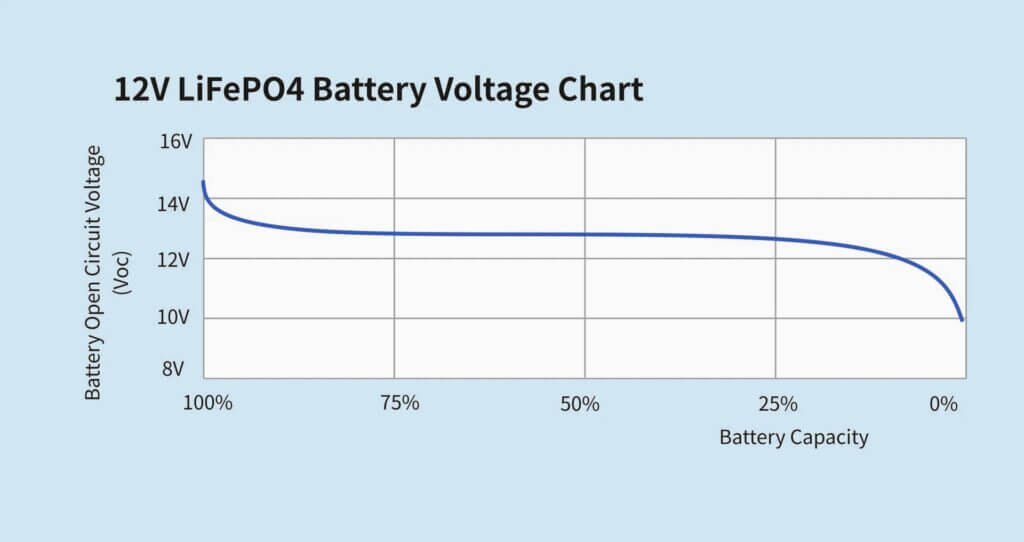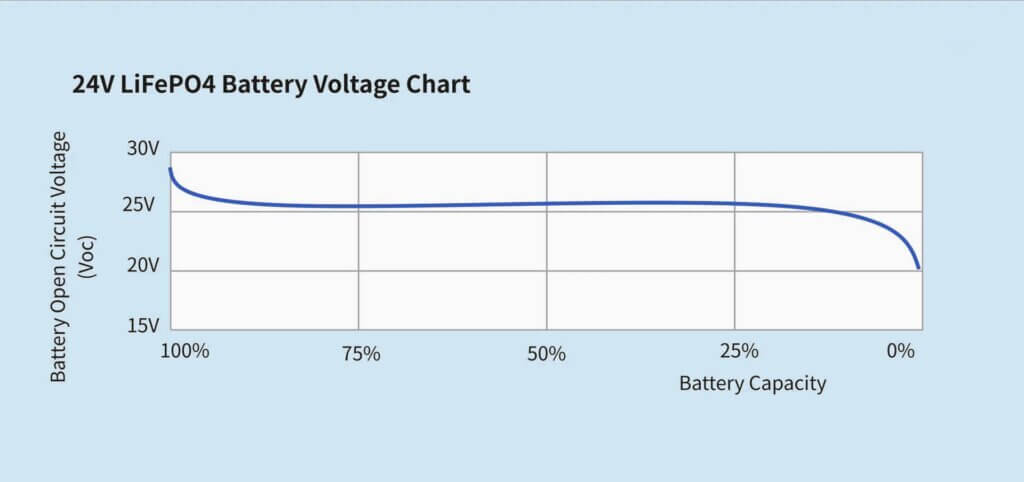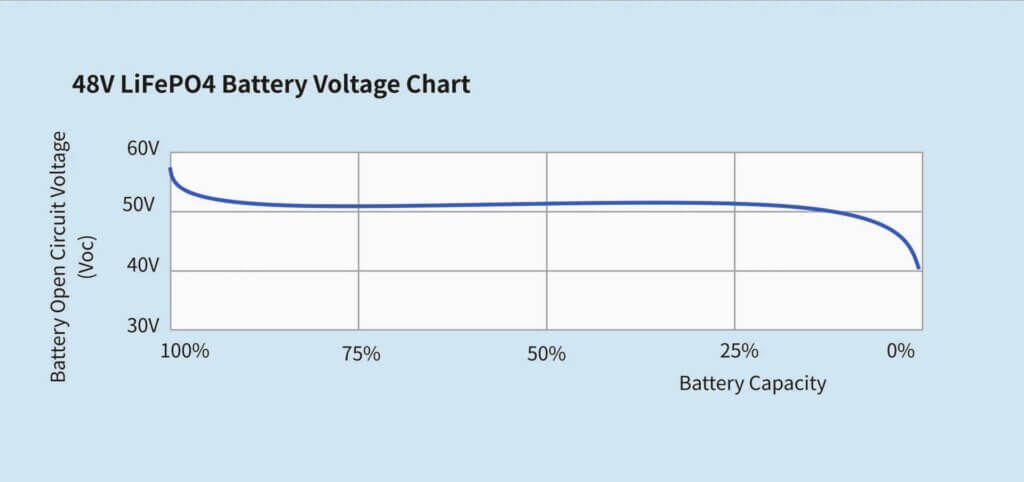Lithium Iron Phosphate (LiFePO4) batteries are becoming increasingly popular due to their advantages over traditional lead-acid batteries. To ensure their optimal performance and safe operation, it’s crucial to understand the voltage characteristics of these batteries. This guide will walk you through the different voltage levels of LiFePO4 batteries, including a comprehensive reference chart.
Part 1. What is LiFePO4 Battery Voltage?
LiFePO4, or Lithium Iron Phosphate, is a lithium-ion battery chemistry known for its stability, high energy density, and extended cycle life. The voltage of a LiFePO4 battery refers to the electrical potential difference between its positive and negative terminals. Here we will discuss these voltage levels:
Nominal Voltage
The nominal voltage of a LiFePO4 battery is typically 3.2 volts per cell. This value represents the average operating voltage under standard conditions. For example, a 12V LiFePO4 battery pack consists of four individual cells, each with a nominal voltage of 3.2 volts. Understanding the nominal voltage helps you choose the appropriate battery pack for your needs.
Fully Charged Voltage
When fully charged, a LiFePO4 battery reaches a voltage of approximately 3.6 to 3.7 volts per cell. Exceeding this voltage can lead to overcharging, potentially damaging the battery. A reliable charger with built-in protection mechanisms is essential to prevent overcharging and ensure battery longevity.
Storage Voltage
For optimal storage, LiFePO4 batteries should be kept between 3.2 and 3.3 volts per cell. Storing the battery within this voltage range helps maintain its life and minimizes self-discharge. If you plan to store your LiFePO4 battery for an extended period, it’s important to monitor the voltage and charge it if it drops below the recommended storage level.
Discharge Voltage
The minimum discharge voltage of a LiFePO4 battery is typically 2.5 to 2.8 volts per cell. Discharging below this threshold can cause irreversible damage and significantly reduce the battery’s lifespan. To protect your battery and extend its life, it’s recommended to use a Battery Management System (BMS) to prevent over-discharge.
Deep Discharge
Deep discharge refers to discharging a battery to its lowest voltage level. While LiFePO4 batteries are more tolerant of deep discharges than other lithium-ion batteries, it’s best to avoid deep discharging whenever possible. Doing so can lead to capacity loss and negatively impact the battery’s performance.
Part 2. LiFePO4 Voltage Chart: 3.2V, 12V, 24V, 48V Configurations
Understanding the relationship between State of Charge (SoC) and voltage is crucial for effective battery management. Here is a voltage chart that describes the SoC ranges for different LiFePO4 battery pack configurations:
| State of Charge (SoC) | 3.2V Configuration | 12V Configuration | 24V Configuration | 48V Configuration |
|---|---|---|---|---|
| State of Charge 0% | 2.5V – 3.0V | 10.0V – 12.0V | 20.0V – 24.0V | 40.0V – 48.0V |
| State of Charge 10% | 3.0V – 3.2V | 12.0V – 12.6V | 24.0V – 25.2V | 48.0V – 50.4V |
| State of Charge 20% | 3.2V – 3.3V | 12.6V – 13.2V | 25.2V – 26.4V | 50.4V – 52.8V |
| State of Charge 30% | 3.3V – 3.4V | 13.2V – 13.8V | 26.4V – 27.6V | 52.8V – 55.2V |
| State of Charge 40% | 3.4V – 3.5V | 13.8V – 14.4V | 27.6V – 28.8V | 55.2V – 57.6V |
| State of Charge 50% | 3.5V – 3.6V | 14.4V – 15.0V | 28.8V – 30.0V | 57.6V – 60.0V |
| State of Charge 60% | 3.6V – 3.7V | 15.0V – 15.6V | 30.0V – 31.2V | 60.0V – 62.4V |
| State of Charge 70% | 3.7V – 3.8V | 15.6V – 16.2V | 31.2V – 32.4V | 62.4V – 64.8V |
| State of Charge 80% | 3.8V – 3.9V | 16.2V – 16.8V | 32.4V – 33.6V | 64.8V – 67.2V |
| State of Charge 90% | 3.9V – 4.0V | 16.8V – 17.4V | 33.6V – 34.8V | 67.2V – 69.6V |
| State of Charge 100% | 4.0V | 17.4V | 34.8V | 69.6V |
For more detailed information on using LiFePO4 batteries in various configurations, you can check out the article on the basics of charging LiFePO4 batteries linked below.
LiFePO4 Battery Voltage and Charging Parameter Guide
Charging Voltage Ranges
The following voltage ranges correspond to different states of charge for LiFePO4 battery pack configurations. Always consult the manufacturer’s specifications for precise voltage values and tolerances.
| Voltage Range (V) | State of Charge |
|---|---|
| 4.0V – 4.2V | During Charging |
| 17.4V – 18.0V | During Charging |
| 34.8V – 36.0V | During Charging |
| 69.6V – 72.0V | During Charging |
| 3.2V – 3.3V | 100% Charged Resting |
| 12.6V – 13.2V | 100% Charged Resting |
| 25.2V – 26.4V | 100% Charged Resting |
| 50.4V – 52.8V | 100% Charged Resting |
This chart helps illustrate the voltage levels at various charging stages. When monitoring the battery’s state of charge, it is important to refer to the manufacturer’s specifications for accurate tolerances and values.
3.2V Configuration Charging Curve

The charging curve for the 3.2V configuration provides important insights into the battery’s state of charge. By examining the voltage chart, you can track how the battery voltage changes during charging.
12V Configuration Charging Curve

The 12V configuration follows a different charging curve. The voltage diagram shows how the battery charges through its various states, reflecting the relationship between voltage and charge level throughout the process.
24V Configuration Charging Curve

The 24V configuration presents its own charging curve. The voltage graph demonstrates how the battery voltage changes as the charge level progresses. This data is essential for understanding the charging behavior of 24V LiFePO4 batteries.
48V Configuration Charging Curve

Finally, the 48V configuration also has a unique charging curve. Observing the voltage profile provides a clear understanding of how the battery voltage evolves through different charging states, helping users manage their charging process effectively.
LiFePO4 Battery Charging Parameters
Proper charging is crucial for the lifespan and performance of LiFePO4 batteries. Here are the key characteristics and corresponding values for 3.2V, 12V, 24V, and 48V configurations:
| Characteristic | 3.2V | 12V | 24V | 48V |
|---|---|---|---|---|
| Charging Voltage | 3.6V | 14.4V | 28.8V | 57.6V |
| Float Voltage | 3.3V | 13.2V | 26.4V | 52.8V |
| Maximum Voltage | 3.9V | 15.6V | 31.2V | 62.4V |
| Minimum Voltage | 2.5V | 10.0V | 20.0V | 40.0V |
| Nominal Voltage | 3.2V | 12.0V | 24.0V | 48.0V |
These values provide a comprehensive overview of charging and float voltages, as well as the safe operating voltage ranges for different LiFePO4 battery configurations. It is essential to adhere to these guidelines to ensure optimal charging and battery health.
Fast, Float, and Equalization Charging
LiFePO4 batteries go through specific charging phases. Each phase has different voltage requirements to achieve efficient and safe charging:
Fast Charging
Fast charging is the initial phase where the battery is charged rapidly at a higher voltage to quickly restore energy. It is the “boost” phase to bring the battery close to its maximum capacity.
Float Charging
Once the battery reaches its desired charge level, it transitions to float charging. In this phase, the battery is maintained at a lower voltage to sustain its charge without overcharging. Float charging is a gentle maintenance charge that ensures the battery remains in a stable, fully charged state.
Equalization Charging
LiFePO4 batteries do not require equalization charging. Equalization charging is typically used for other types of batteries to balance the voltage of individual cells. Because of the stable voltage profile of LiFePO4 batteries, they do not experience significant cell imbalances, making equalization unnecessary.
Charging Parameters for Bulk and Float Phases
Here are the specific voltage requirements for the bulk and float charging phases for 3.2V, 12V, 24V, and 48V configurations:
| Charging Type | 3.2V | 12V | 24V | 48V |
|---|---|---|---|---|
| Bulk | 3.6V | 14.4V | 28.8V | 57.6V |
| Float | 3.3V | 13.2V | 26.4V | 52.8V |
LiFePO4 batteries rely on bulk charging to quickly bring the battery up to the target voltage. Once the target voltage is reached, the battery switches to float charging, where a stable, lower voltage maintains the charge.
Factors Affecting LiFePO4 Battery Voltage
Several factors can influence the voltage characteristics of LiFePO4 batteries, impacting their performance and efficiency:
Temperature
Temperature plays a crucial role in the voltage behavior of LiFePO4 batteries. Both extreme heat and extreme cold can affect the battery’s internal resistance, capacity, and overall voltage readings. It is important to operate and charge the batteries within the recommended temperature ranges to prevent any potential performance issues or battery damage.
This guide provides an overview of LiFePO4 battery charging and voltage parameters. Always refer to the manufacturer’s specifications for accurate, specific information.
LiFePO4 Battery Voltage Overview
Key Factors Affecting Battery Voltage
State of Charge (SOC)
The state of charge (SOC) reflects the remaining capacity of the battery. The voltage of a LiFePO4 battery varies depending on its SOC, allowing users to understand the battery’s remaining charge. Monitoring this voltage provides a rough estimate of the SOC, helping users manage their power resources more effectively.
Load Current
Load current refers to the current drawn from the battery when it is discharging. High load currents can cause voltage drops due to internal resistance. It’s important to consider load current when designing systems or selecting LiFePO4 batteries for specific applications, as it impacts the battery’s voltage performance.
Battery Life and Cycle Life
As LiFePO4 batteries age and undergo charge-discharge cycles, their voltage characteristics may change. Capacity loss and increased internal resistance can lead to voltage deviations. Regular monitoring of the battery’s voltage and capacity provides insights into its health, enabling timely replacement or maintenance.
Frequently Asked Questions (FAQ)
What is the recommended charging voltage for a LiFePO4 battery?
For optimal performance and longevity, it is recommended to charge LiFePO4 batteries to a range of 3.3 to 3.6 volts per cell.
Can I charge a LiFePO4 battery with 13.8V?
It is not recommended to directly charge a LiFePO4 battery with 13.8V, as it can lead to overcharging and damage to the battery.
Should LiFePO4 batteries be charged to 100%?
It is recommended to charge LiFePO4 batteries to around 90% rather than 100%. This approach can help extend the battery’s lifespan and prevent undue stress on the cells.
What is the best way to charge a LiFePO4 battery?
To charge LiFePO4 batteries, use a charger specifically designed for these batteries and follow the CC-CV (Constant Current-Constant Voltage) charging method. This ensures safe, efficient charging, maximizing both performance and lifespan.
Growth Trends in the Flexible Thin-Film and Printed Battery Market
The flexible thin-film and printed battery market is developing rapidly. This article explores the market’s growth, innovations, challenges, and emerging trends in the industry.
KHZH is committed to providing in-depth insights on the development trends of this emerging industry. Please check back regularly for the latest information on market dynamics and battery technology.







